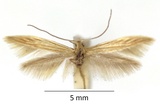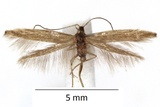Coleophora taeniipennella Herrich-Schäffer, [1855] Species
Last modified: Nov. 28, 2025, 2:04 p.m.
A very rare and local species in Belgium.
Details
- Classification
- Family: Coleophoridae > Genus: Coleophora > Species: Coleophora taeniipennella
- Vernacular names
- Gestreepte ruskokermot (NL), Small rush case-bearer (EN)
- Synonyms
- Coleophora galactaula Meyrick, 1828
- First mention in Belgium
- Janmoulle E. 1956. Espèces nouvelles pour la faune belge (suite). — Lambillionea 56: 1, 58, 81. On page 1.
- Status
-
Native
Distribution
Case
The 5 mm, trivalved, and well-camouflaged case is made inside a Juncus flower and has a mouth angle of 20°.
No pictures yet!
Bionomics
The eggs are deposited on a flower of the food plant. The young larvae live in a fruitlet and eat the seeds. Later on, a case is formed and the larvae eat the fruits from the outside.
Larvae from August till November.
The full-fed larva generally leaves to host plant to hibernate elsewhere.
Pupation in the following spring, is still the case.
No pictures yet!
Flight periods
They are on the wing from mid-June till the beginning of August.
Observed on
- Host plant (species):
- Juncus articulatus and Juncus acutiflorus
- Host plant (genera):
- Juncus
Mainly Juncus articulatus & acutiflorus.
No pictures yet!
Habitat
The food plant stands in rather moist area's.
No pictures yet!



